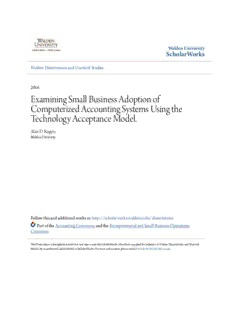Table Of ContentWalden University
ScholarWorks
Walden Dissertations and Doctoral Studies
Walden Dissertations and Doctoral Studies
Collection
2016
Examining Small Business Adoption of
Computerized Accounting Systems Using the
Technology Acceptance Model.
Alan D. Rogers
Walden University
Follow this and additional works at:https://scholarworks.waldenu.edu/dissertations
Part of theAccounting Commons, and theEntrepreneurial and Small Business Operations
Commons
This Dissertation is brought to you for free and open access by the Walden Dissertations and Doctoral Studies Collection at ScholarWorks. It has been
accepted for inclusion in Walden Dissertations and Doctoral Studies by an authorized administrator of ScholarWorks. For more information, please
[email protected].
Walden University
College of Management and Technology
This is to certify that the doctoral study by
Alan Rogers
has been found to be complete and satisfactory in all respects,
and that any and all revisions required by
the review committee have been made.
Review Committee
Dr. Mary Dereshiwsky, Committee Chairperson, Doctor of Business Administration
Faculty
Dr. Roger Mayer, Committee Member, Doctor of Business Administration Faculty
Dr. Matthew Knight, University Reviewer, Doctor of Business Administration Faculty
Chief Academic Officer
Eric Riedel, Ph.D.
Walden University
2016
Abstract
Examining Small Business Adoption of Computerized Accounting Systems Using the
Technology Acceptance Model
by
Alan D. Rogers
MBA, The Ohio State University, 1988
BSBA, Franklin University, 1986
Doctoral Study Submitted in Partial Fulfillment
of the Requirements for the Degree of
Doctor of Business Administration
Walden University
January 2016
Abstract
Small business owners who fail to adopt modern technology risk placing themselves at a
competitive disadvantage. Drawing on Davis’s technology acceptance model, the
purpose of this study was to examine how small business owners in Central Ohio come to
accept and use computerized accounting systems (CAS). The research question
addressed the correlation between perceived ease of use, perceived usefulness, and the
intent to adopt CAS using multiple linear regression. Data were collected using a survey
mailed to 347 small business owners which yielded a sample size of 71 respondents.
Results showed a positive correlation between perceived ease of use, perceived
usefulness, and the intent to adopt CAS; therefore, the null hypothesis was rejected. The
model predicted about 71% of the variations in intent to adopt CAS. Using the portion of
the sample where small business owners had not yet adopted CAS (n = 34), the model
was able to predict about 63% of the variation, and in the portion where small business
owners had already adopted CAS (n = 37), the model was able to predict about 70% of
the variation. However, when splitting the sample between small businesses whose
owners had already adopted CAS and those who had not yet adopted CAS, importance of
ease of use and usefulness changed. Usefulness is more important to nonadopters and
ease of use is more important for continued use. The implication for social change is the
potential to reduce business failures. The study showed that 83% of small businesses
over 5 years old currently use a CAS and only 56% under 5 years old use a CAS. Society
could benefit from an increase in the number of successful small businesses, which would
then contribute to economic expansion.
Examining Small Business Adoption of Computerized Accounting Systems Using the
Technology Acceptance Model
by
Alan D. Rogers
MBA, The Ohio State University, 1988
BSBA, Franklin University, 1986
Doctoral Study Submitted in Partial Fulfillment
of the Requirements for the Degree of
Doctor of Business Administration
Walden University
January 2016
Dedication
I would like to dedicate this work to Nada, my wife, my life-long partner, the love
of my life, and best friend. Thank you for your support, encouragement, and unwavering
faith.
Acknowledgments
I would like to thank my Chair Dr. Mary Dereshiwsky for her guidance and
support through this journey. Your support and words of encouragement kept me
focused on the end result. I would also like to thank my committee member Dr. Roger
Mayer for his valuable input and expertise in the field of accounting. Finally, thank you
Dr. Matthew Knight for providing an additional set of eyes, which helped keep
everything in perspective.
Table of Contents
List of Tables ..................................................................................................................... iv
Section 1: Foundation of the Study ......................................................................................1
Background of the Problem ...........................................................................................1
Problem Statement .........................................................................................................3
Purpose Statement ..........................................................................................................3
Nature of the Study ........................................................................................................4
Research Question .........................................................................................................5
Hypotheses .....................................................................................................................5
Survey Questions Information ................................................................................ 5
Theoretical Framework ..................................................................................................6
Operational Definitions ..................................................................................................7
Assumptions, Limitations, and Delimitations ................................................................8
Assumptions ............................................................................................................ 9
Limitations ............................................................................................................ 10
Delimitations ......................................................................................................... 10
Significance of the Study .............................................................................................11
Contribution to Business Practice ......................................................................... 11
Implications for Social Change ............................................................................. 12
A Review of the Professional and Academic Literature ..............................................13
Small Business Survival and Failure .................................................................... 14
The Technology Acceptance Model ..................................................................... 23
i
Computerized Accounting Systems ...................................................................... 32
Transition and Summary ..............................................................................................43
Section 2: The Project ........................................................................................................44
Purpose Statement ........................................................................................................44
Role of the Researcher .................................................................................................44
Participants ...................................................................................................................46
Research Method and Design ......................................................................................47
Research Method .................................................................................................. 47
Research Design.................................................................................................... 48
Population and Sampling .............................................................................................50
Ethical Research...........................................................................................................52
Instrumentation ............................................................................................................53
Data Collection Technique ..........................................................................................56
Data Analysis ...............................................................................................................57
Study Validity ..............................................................................................................63
Transition and Summary ..............................................................................................65
Section 3: Application to Professional Practice and Implications for Change ..................67
Presentation of the Findings.........................................................................................67
Tests of Assumptions ............................................................................................ 68
Results ................................................................................................................... 70
Applications to Professional Practice ..........................................................................90
Implications for Social Change ....................................................................................91
ii
Recommendations for Action ......................................................................................91
Recommendations for Further Research ......................................................................92
Reflections ...................................................................................................................93
Summary and Conclusions ..........................................................................................93
References ..........................................................................................................................95
Appendix A: Permission to Adapt Survey Instrument ....................................................118
Appendix B: TAM Survey Instrument ............................................................................120
Appendix C: Researcher’s NIH Certificate .....................................................................124
Appendix D: Sample Spreadsheet ...................................................................................125
Appendix E: Confidentiality Agreement .........................................................................126
iii
Description:accept and use computerized accounting systems (CAS). liberalization of economic and financial policy and the competitive free-market rates.

